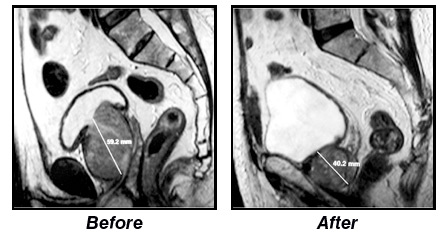Prostate artery embolization (PAE) is a new treatment option for men with benign prostatic hyperplasia (BPH), also known as an enlarged prostate gland. This procedure can greatly reduce BPH symptoms.
Most often patients are discharged from the hospital three hours after the procedure, but sometimes it may be necessary to stay overnight.
Please note: If you were interested in participating in the clinical trial for PAE, that study is currently closed. However, the PAE procedure is currently performed at two Inova locations as outlined below.
Frequently Asked Questions
Having an enlarged prostate, a common part of aging, is also known as Benign Prostatic Hyperplasia (BPH) or benign prostatic hypertrophy.
This occurs when the prostate gland becomes very large, it and may cause problems passing urine. BPH is not cancer.
As the prostate grows, it presses against the urethra, the tube that carries urine out of the body. This interferes with urination. At the same time, the bladder wall becomes thicker and irritated, and begins to contract, even when it contains only small amounts of urine. This can cause more frequent urination. These changes cause the bladder muscle to weaken. It may not empty fully and can leave some urine behind. This leads to symptoms.
- Frequent urination at night
- Frequent urination that often produces only a small amount of urine
- Hesitant or interrupted urine stream
- Leaking or dribbling urine
- Sudden and urgent need to urinate
- Weak urine stream
- Feeling like the bladder is not completely empty after urinating
- Occasional pain when urinating
- Having to rush to the bathroom suddenly after the urge to urinate
- Sometimes complete obstruction when severe
Read more about prostate disease in our online health library
Besides a history and physical examination, you will be asked to fill out a short questionnaire to evaluate the severity of your symptoms. After this, you will meet with the interventional radiologist who will discuss your treatment options and pre-procedure tests. Patients will also need referral to urology if they do not have an existing urologist.
An MRI or ultrasound of the prostate may be ordered as well as a short test to evaluate the rate of urine flow. A blood test is needed to insure a safe procedure.
During the procedure, a small, spaghetti-like catheter is placed via an artery in the right groin into the arteries that supply the prostate. Very small particles are injected into the prostate arteries to decrease blood supply to the prostate, thus reducing its size and symptoms.
Most often patients are discharged from the hospital three hours after the procedure, but sometimes it may be necessary to stay overnight.
It is routine practice to not place a catheter via the penis.
Patients are given a sedative medication for the procedure, similar to that given for a colonoscopy which is often referred to as "twilight sleep." There is no need for general anesthesia. The procedure is not considered painful and some patients elect to have no sedation.
Results are very promising with greater than 90 percent of patients seeing extreme improvement. Approximately 7 percent of patients see moderate improvement and 1 to 2 percent may see no improvement.
Yes.
